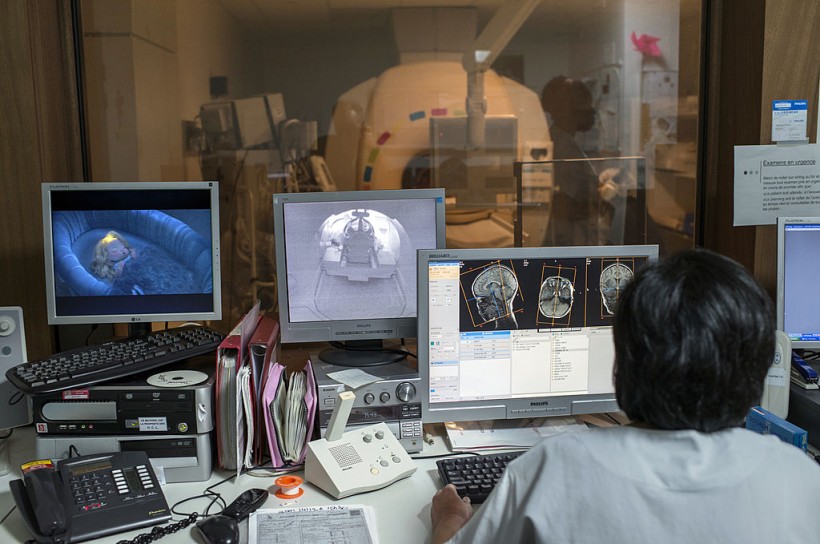The Salk Institute for Biological Studies experts conducted research on activating mammalian cells using ultrasound.
The authors' approach aims to be a stepping stone for innovations in non-invasive treatments of deep brain stimulation, insulin pumps, and pacemakers. The results were tested with human cells and the brain cells of mice subjects.
Sonogenetics in Mammalian Cells
TO GO WITH AFP STORY BY ANNE-PASCALE REBOUL A doctor controls the progress of an MRI (Magnetic resonance imaging or Imagerie par résonance magnétique - IRM in French) of a child who first underwent a fake preparatory CT scan. on December 14, 2012 at the Bron hospital next to Lyon, eastern France. Paediatric radiology department chief of Bron's hospital, Professor Jean-Pierre Pracros, adopted this practice to avoid systematic anesthesia for young patients undergoing a MIR.
Salk's Molecular Neurobiology Laboratory expert and senior author of the study Sreekanth Chalasani said in a SciTechDaily report that their team used a wireless activation approach through the safe ultrasound procedures.
Ultrasound is considered by experts the best choice for manipulating cells deep inside the human body. Aside from being the most secure method, the new wireless cell activation could go through any mass inside the body, such as muscles, tissues, and bones.
Chalasani coined the term "sonogenetics," a method in which ultrasonic waves are used to stimulate or manipulate certain cell groups. Among the most notable research by Chalasani and colleagues is the activation of cells in a roundworm called Caenorhabditis elegans. In this 2015 study, the team added the low-frequency ultrasound-inducing protein known as TRP-4 to the neurons of the roundworms, activating the animal's cells successfully through medical sonograms.
In mammalian cells, the TRP-4 protein can not push cells to respond to ultrasound. Although other mammals were ultrasound-sensitive, their capacity is not fit for clinical use. With that said, the experts searched for a new mammalian protein that could activate ultrasound response in cells at a frequency of 7 millihertz.
Salk biologist and co-author of the paper Yusuf Tufail said in the report that their team's approach is totally distinct from the initial studies as they funneled every cell that could possibly work as the new ultrasound channel.
The team comprehensively screened hundred of protein varieties one by one and added them into a commonhuman research cell line (HEK). Most of the cells are unresponsive to ultrasound, according to the authors. Each cell culture was then observed in a series of tests involving ultrasound stimulation.
TRPA1 Gene Activates Cells as Response to Ultrasound
Over a year, the authors completed the screening of almost 300 cells that are probably fit for the job. The examination brought up a potential channel protein called TRPA1, which is the only piece that makes HEK cells sensitive to the 7-millihertz ultrasound frequency.
The TRPA1 was discovered to activate cells throughout to body upon ultrasound administration. Parts of the human system that the protein can regulate are the heart and brain. In an unexpected event, the channel itself also responded when the HEK cells met ultrasounds.
CO-author Marc Duque said that they were surprised by the protein's reaction. TRPA1 was already known in the field but was not explained as a protein with a mechanosensitive feature that is expected to respond to ultrasound, Duque added.
Gene therapy was performed by the experts to test if the same channel could activate other types of cells. The process carried out the addition of genes for the human TRPA1 protein to the brain cells of living mice subjects. As a result, the neurons which had the TRPA1 genes were the only cells activated.
Sonogenetics, according to the experts, is the future of the present-day deep-brain stimulation treatments for neurological conditions such as epilepsy and Parkinson's disease. Pacemaker implantation and other approaches would be exceeded by the effectiveness of sonogenetic treatments through its non-invasive and convenient procedures.
Future studies will be dedicated to the main factor that drives the TRPA1 channel protein to modify ultrasound sensitivity, according to co-author Corinne Lee-Kubli.
The study titled "Sonogenetic control of mammalian cells using exogenous Transient Receptor Potential A1 channels" was published in the journal Nature Communications.
RELATED ARTICLE: Genetic Mutation From Ancient Wolves 53,000 Years Ago Made Some Dog Breeds to Have Smaller Body
Check out more news and information on Biology in Science Times.















